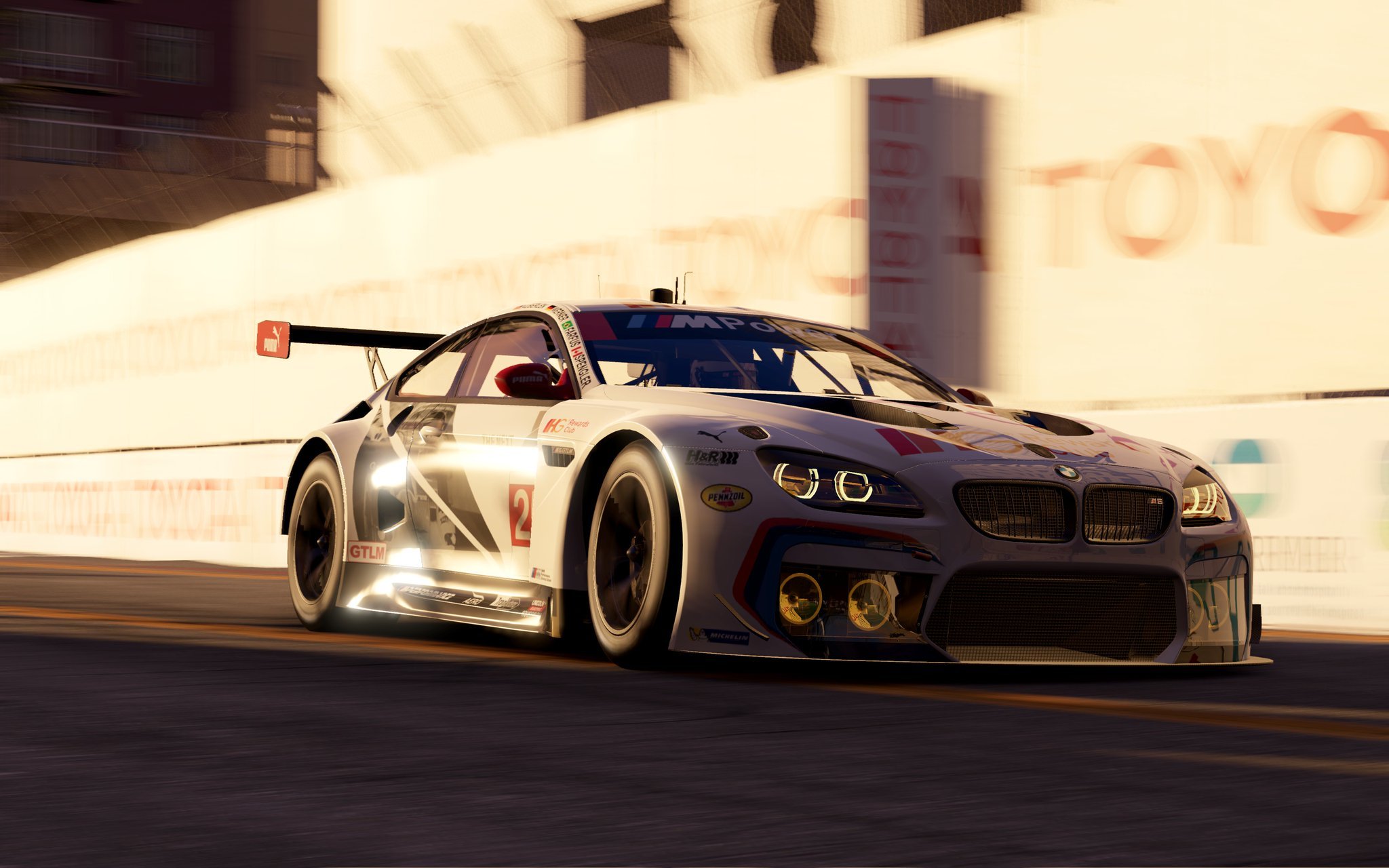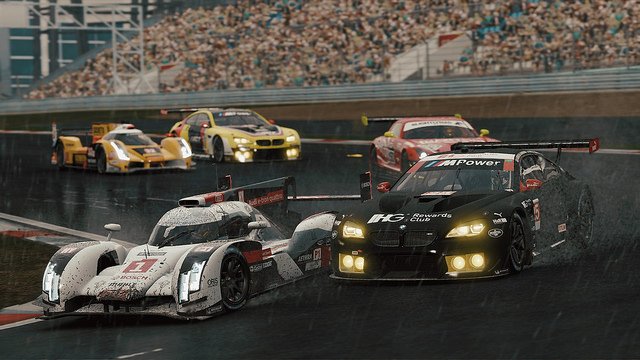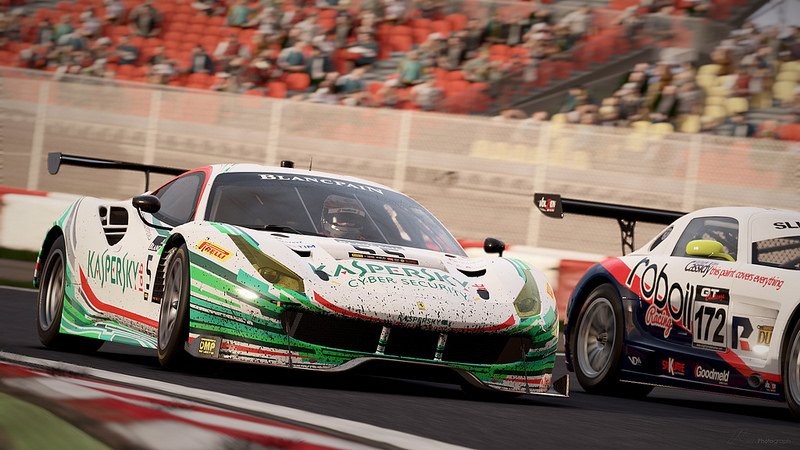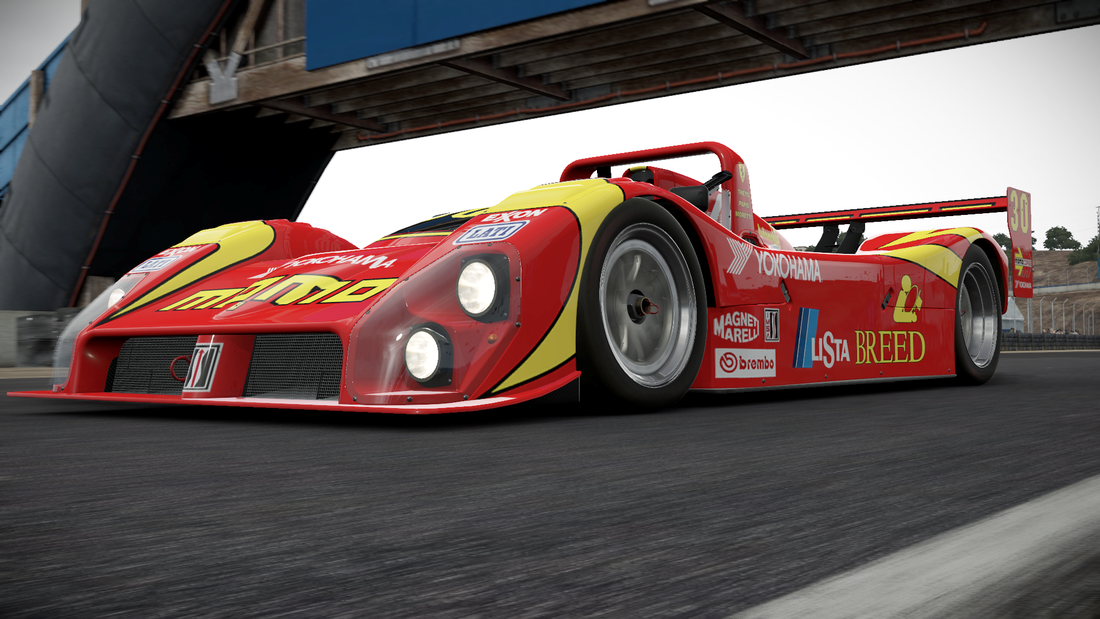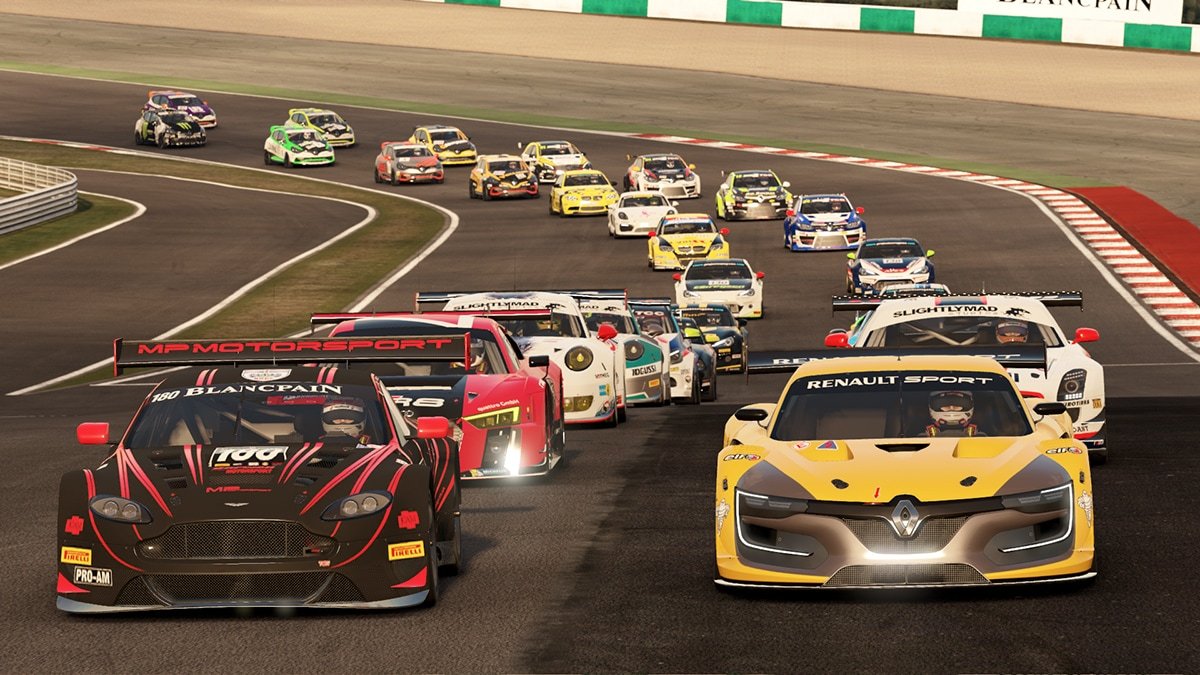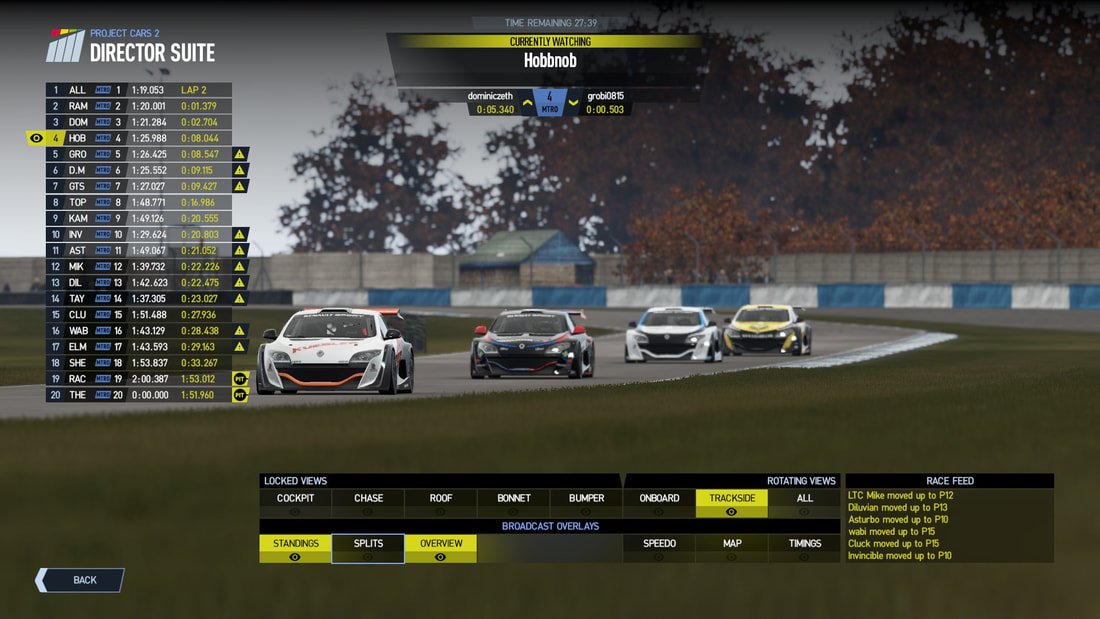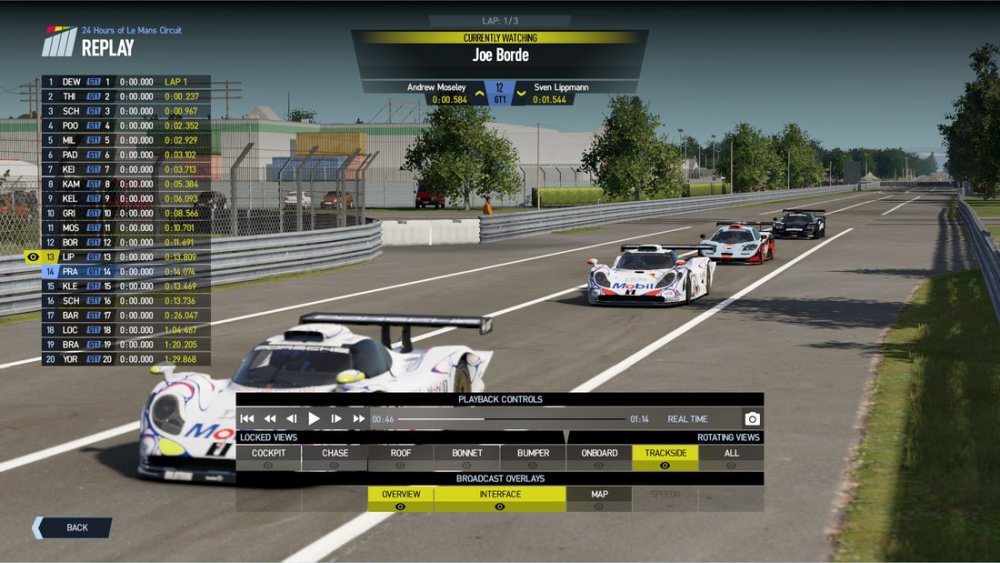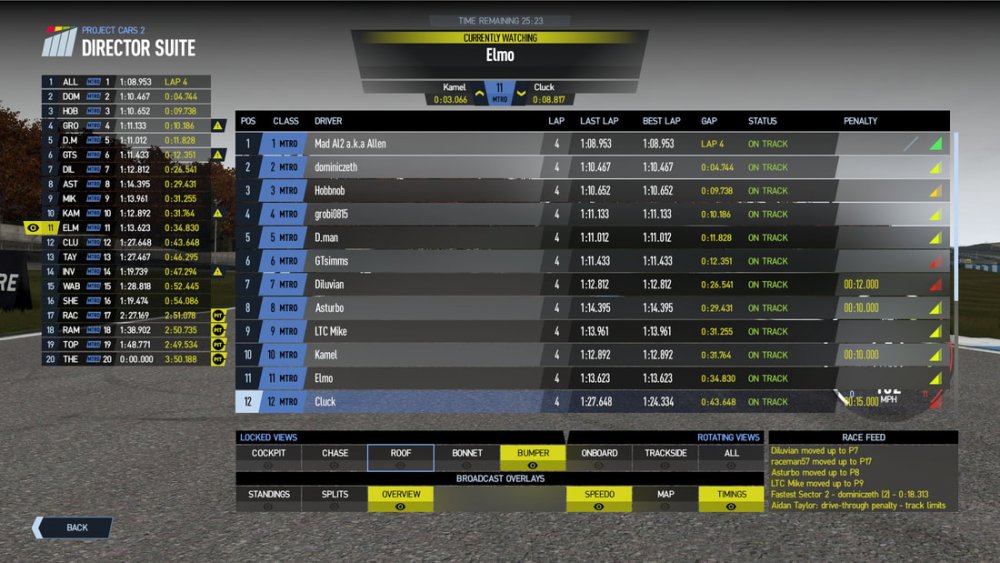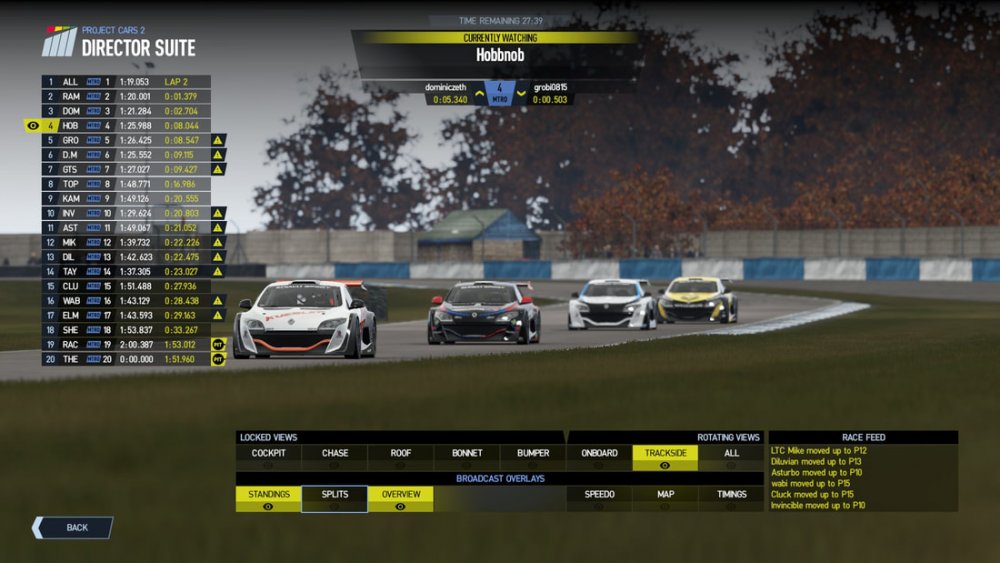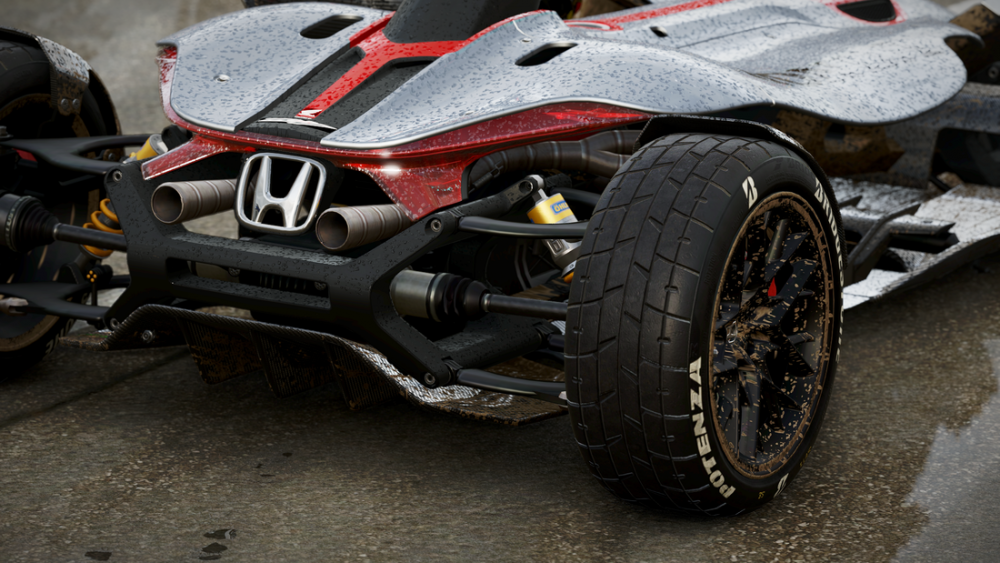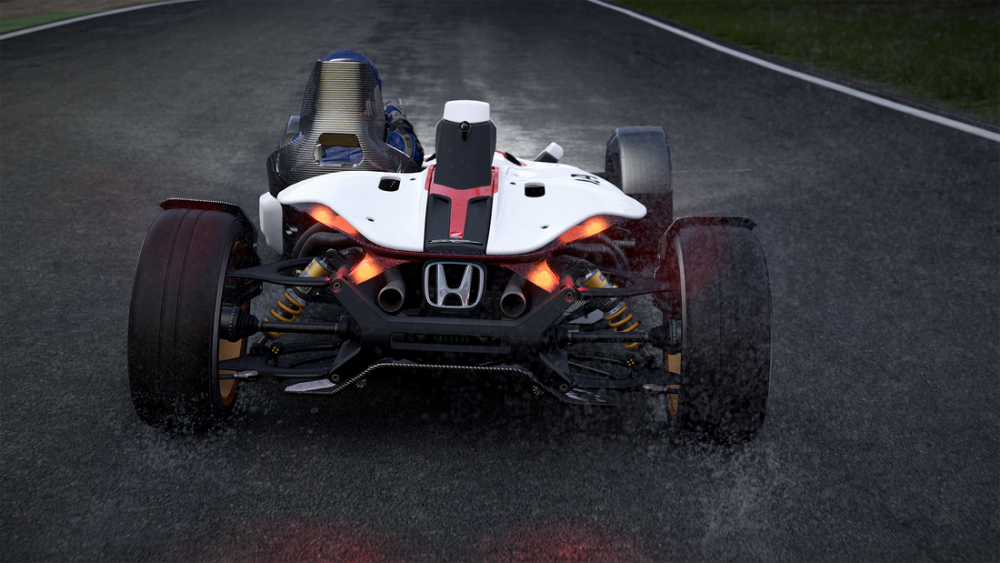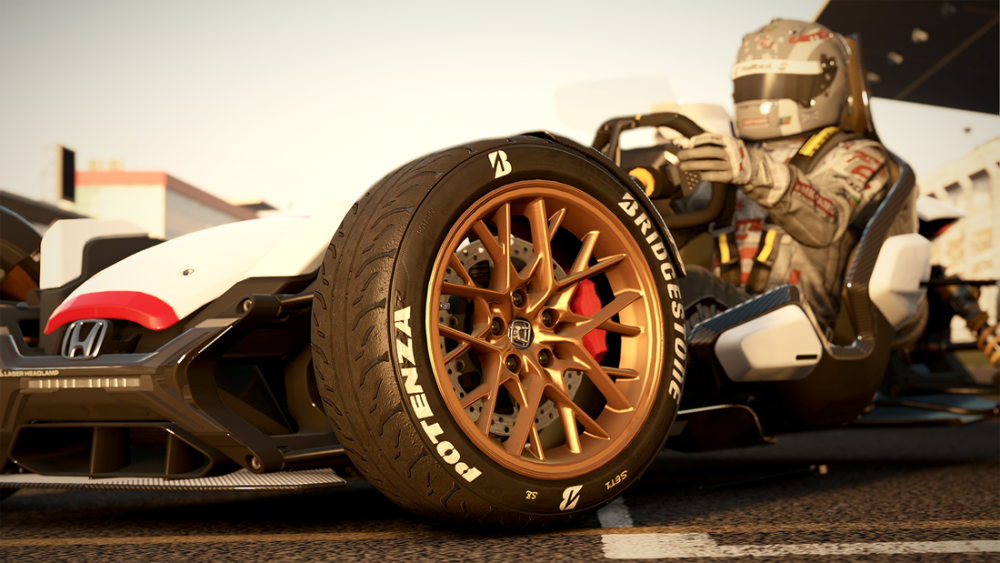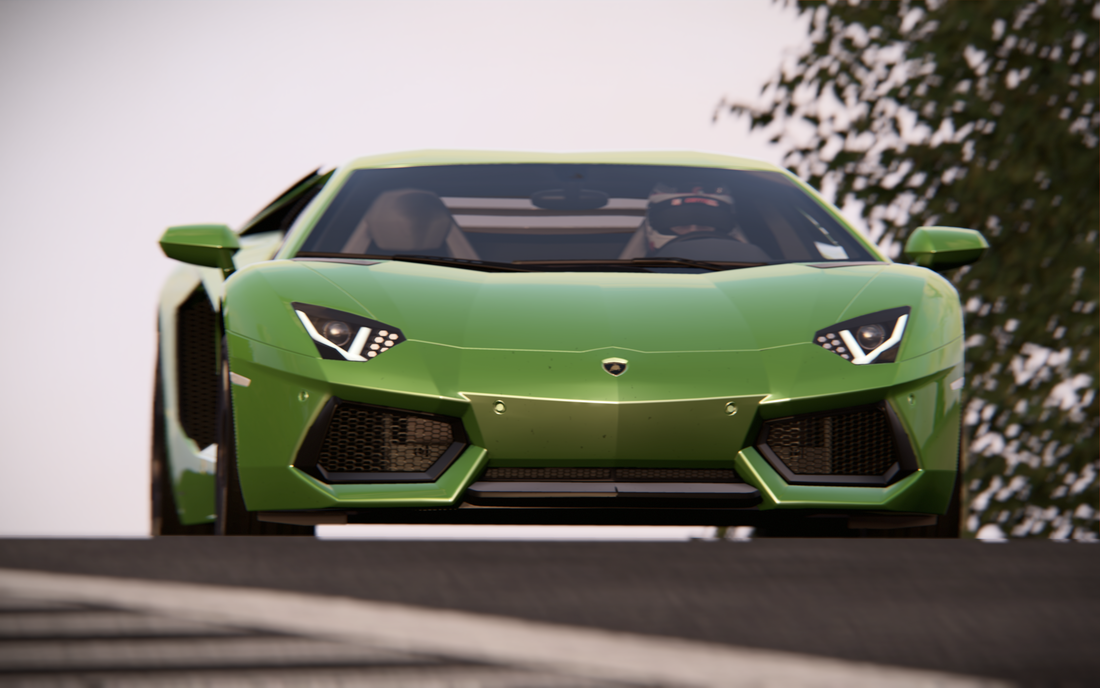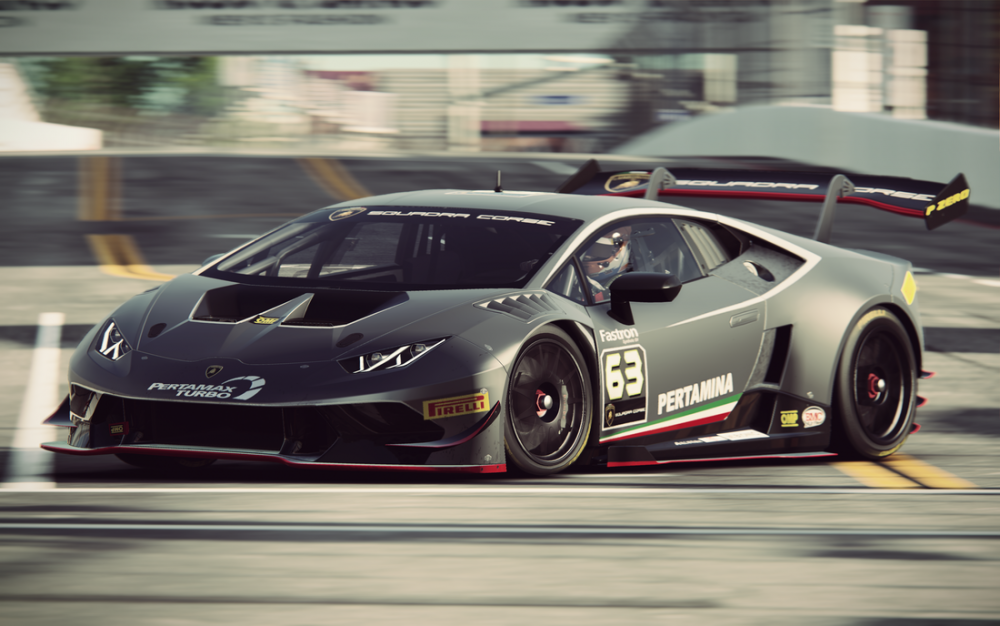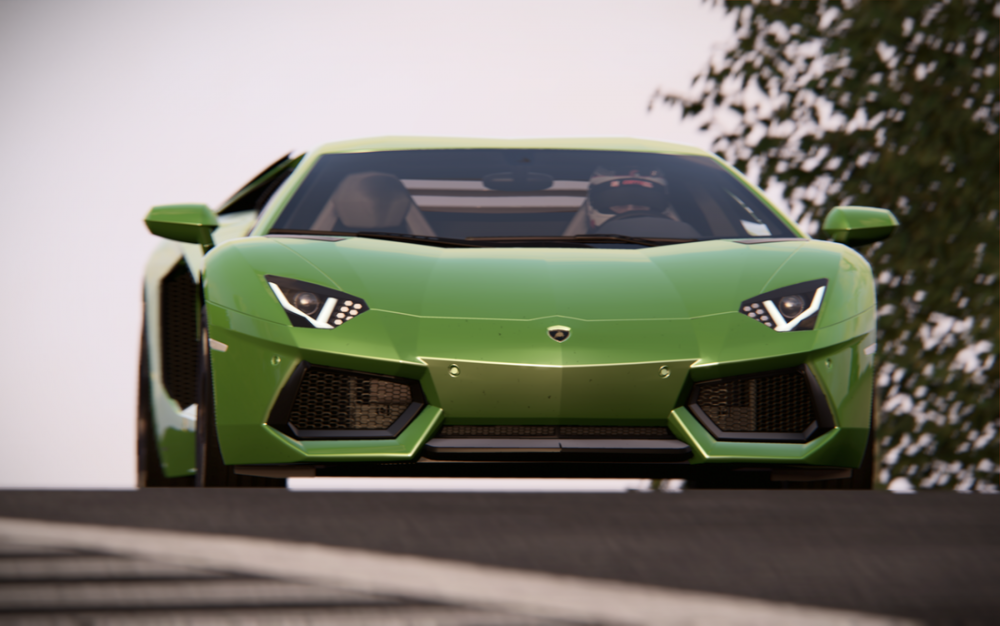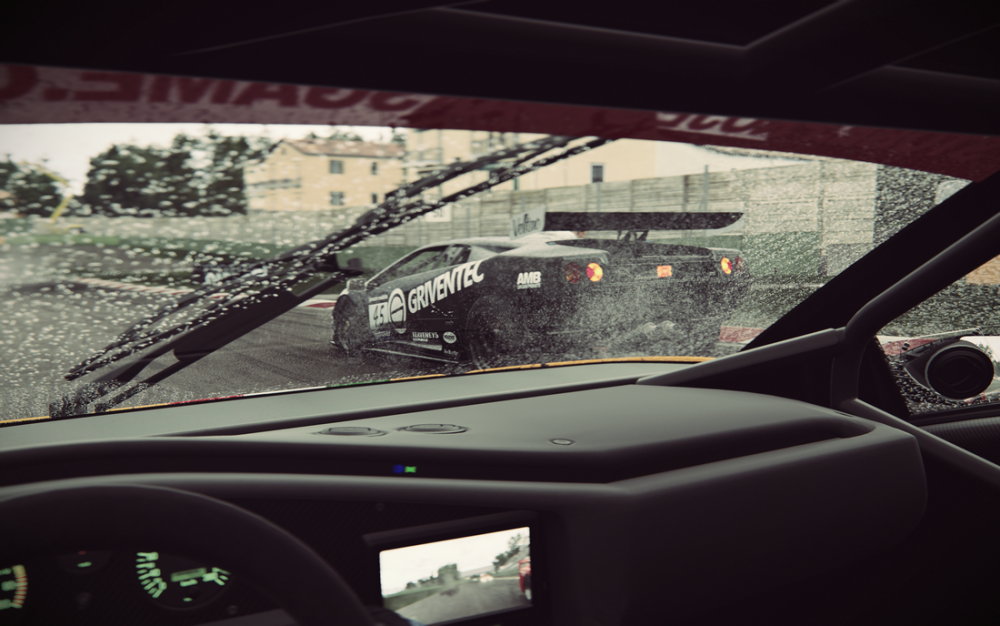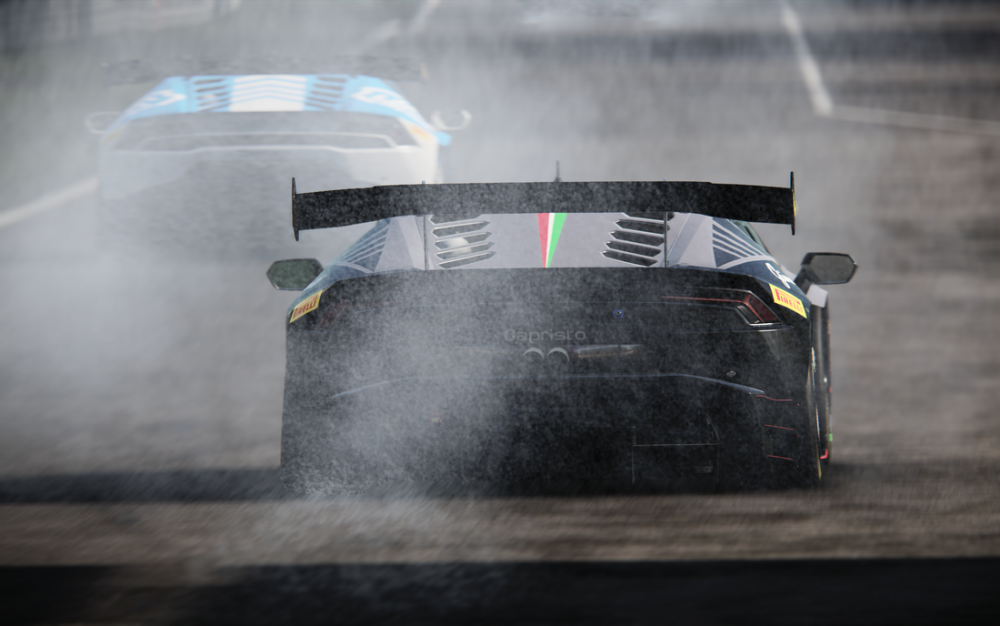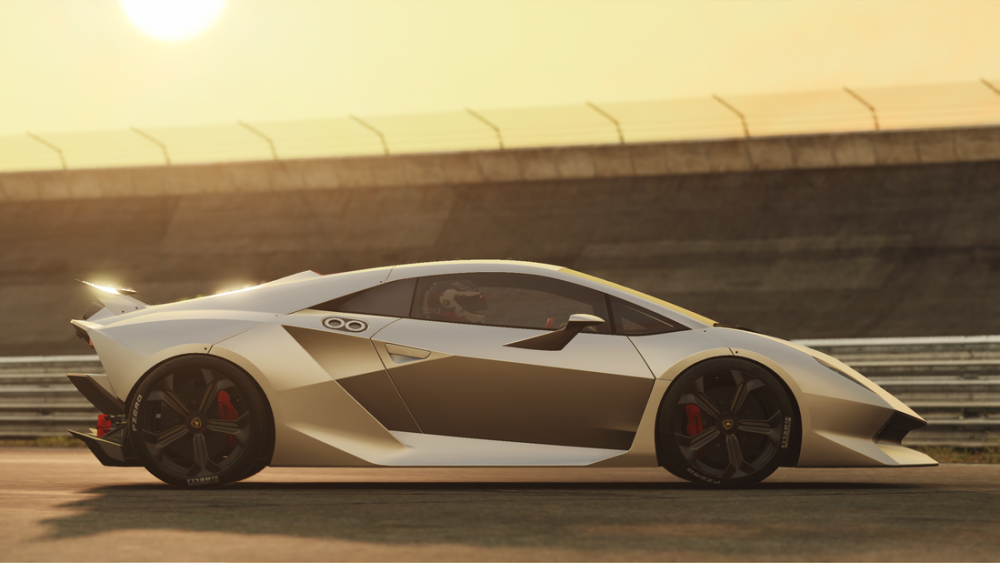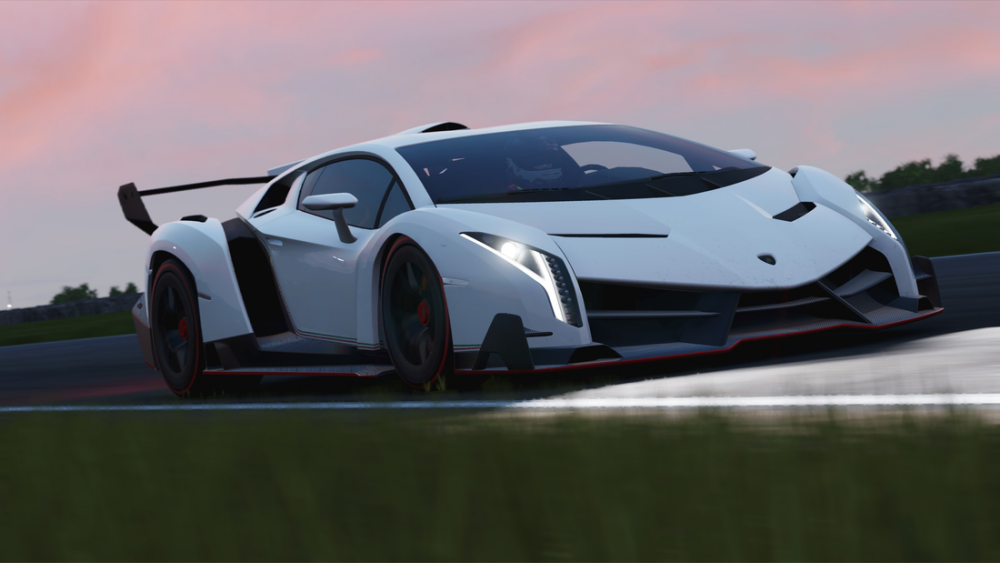Search the Community
Showing results for tags 'project cars 2'.
-
Direttamente dalla pagina Steam del gioco, è possibile scaricare la versione demo dell'ultimo Project CARS 2 targato Slightly Mad Studios. Il dimostrativo ci permette di guidare la Ferrari 488 GT3, la Lamborghini Huracán, e la Formula Renault 3.5 sul circuito in laser scan del Red Bull Ring. Tutti i dettagli sulla demo sono disponibili a questo link.
-
Slightly Mad Studios ha reso disponibile per Project CARS 2 il già noto Japanese Car Pack' DLC, acquistabile per Xbox One, PlayStation 4 e PC. Il nuovo DLC ci offre 4 vetture giapponesi: Nissan R32 Skyline GT-R, Nissan 280ZX GTX, Honda Civic Type R e Honda 2&4 Concept. Il pacchetto era in origine inserito come contenuto bonus nel pre ordine del gioco, quindi adesso può essere acquistato da tutti gli utenti direttamente su Steam a 4,99€. Esplora la ricca tradizione dei motori giapponesi con il Japanese Cars Bonus Pack. Goditi le iconiche meccaniche JDM di Nissan con la famigerata R32 Skyline GT-R del Gruppo A e la sublime auto da corsa 280ZX GTX. Sperimenta poi la potenza di un'auto sportiva moderna con la Euro-spec Honda Civic Type R e goditi un assaggio del futuro con il prototipo 2&4 di Honda, una collaborazione da 13.000rpm tra un design automobilistico e una moto, nel nome delle prestazioni.
-
- japanese car pack
- japanese car pack dlc
-
(and 1 more)
Tagged with:
-

Project CARS 2 Insider Guide: parliamo di pit stop e force feedback
VELOCIPEDE posted a article in Software
-
-
Fra i tantissimi video dedicati a Project CARS 2, vi segnaliamo i primi due capitoli della serie denominata The Insider's Guide to Project CARS 2: in pratica una video guida a puntate dedicata a vari argomenti specifici del gioco targato Slightly Mad Studios. I primi due capitoli, che trovate anche qui sotto, focalizzano l'attenzione sugli aiuti disponibili in game e sulle possibili strategie ai box.
-
Matt York del team Slightly Mad Studios ci presenta in video le vetture del Motorsport Car Pack di Project CARS 2, il DLC incluso nel Season Pass del gioco che include 4 auto esclusive: Jaguar E-Type V12 del 1974, Audi V8 DTM del 1991, Panoz Esperante GTR-1 1997, Opel Astra TCR Touring Car 2016. Vi ricordiamo che sono già previsti altri 4 DLC per Project CARS 2, ma non sono ancora stati annunciati i contenuti.
-
BANDAI NAMCO Entertainment Europe e Slightly Mad Studios sono lieti di annunciare il ritorno della ESL Go4 Cup, che debutterà con il nuovo e pluriacclamato Project CARS 2, il 22 ottobre 2017. A seguito di una stagione straordinaria, che ha visto la Project CARS ESL Go4 Cup diventare la principale competizione di corse eSports della ESL, culminata con la Finale mondiale che si è tenuta live alla Gamescom 2017, la Project CARS 2 ESL Go4 Cup riporterà la sfida e la competizione che tutti i giocatori si attendono, aggiungendo anche una nuova dimensione, grazie al realismo e l'autenticità di Project CARS 2. A partire dal 22 ottobre 2017, i giocatori di tutta Europa inizieranno una nuova stagione di competizioni, battaglie e rivalità serrate attraverso 39 coppe e 9 finali mensili su tutte e tre le piattaforme, PlayStation®4, Xbox One e PC (STEAM). Ogni settimana, la ESL terrà una Project CARS 2 ESL Go4 Cup settimanale su play.eslgaming.com/projectcars, che ricompenserà il miglior pilota con 50,00 € per piattaforma. Inoltre, i 12 migliori piloti di ogni mese si sfideranno in una finale mensile per un premio di 100,00 € su ogni piattaforma. Nelle corse eSports non si gareggia solo per la vittoria e la Project CARS 2 ESL Go4 Cup non è riservata solo ai migliori piloti delle migliori squadre, ma si tratta di mettersi alla prova e competere, gareggiare, divertirsi e apprezzare le amicizie e lo spirito cameratesco della competizione e delle corse stesse. La Project CARS 2 ESL Go4 Cup è aperta a tutti, su tutte e tre le piattaforme
-
- project cars 2 esl go4 cup
- project cars 2
-
(and 1 more)
Tagged with:
-
FIVE CARS IN PROJECT CARS 2 BECOME HOT WHEELS DIECAST VEHICLES You’ve seen them on the most famed race tracks on the planet, you’ve raced them in Project CARS 2 in all their high-performance glory, now you can own them as Hot Wheels diecast cars.
-
Slightly Mad Studios ha rilasciato la prima patch fix ufficiale per correggere alcuni problemi di Project CARS 2, trovate tutti i dettagli a questo link. Unicamente con Project CARS 2 in versione PC è possibile utilizzare i "tweaker" per il force feedback realizzati dall'ormai famoso Jack Spade, che danno la possibilità di preimpostare i valori del force feedback scegliendo di utilizzare un file unico valido per tutte le vetture oppure un file specifico per ciascuna auto. Questi files, in formato xml, contengono ulteriori parametri oltre a quelli che è possibile settare in game e vanno posizionati in una cartella denominata "FFB", da creare in documenti\Project CARS 2. I più esperti potranno anche regolarsi il FFB a proprio piacimento, anche a seconda del modello di volante. Non dimenticate di regolare la riduzione della zona morta.
-
La nostra recensione l'avrete già letta, seguiranno ulteriori speciali ed approfondimenti, invito quindi tutti quelli che hanno provato l'ultimo titolo SMS ha scrivere qui sotto pareri ed impressioni, in particolare riguardo al lato simulativo del gioco. Naturalmente evitiamo polemiche e inutili confronti.
-
In una intervista a SpotTheOzzie, Ian Bell, gran capo di Slighty Mad Studios, ben noto sviluppatore di Project CARS 2, ha raccontato di come Electronic Arts li abbia quasi rovinati, tentando persino di sottrargli la loro tecnologia: dopo Need for Speed: Shift 1 e 2, Electronic Arts gli ha offerto 1,5 milioni di dollari per non lavorare con altri publisher, accordo che prevedeva anche lo sviluppo di Need For Speed: Shift 3. Firmato il contratto, senza alcun preavviso, Electronic Arts ha cancellato il gioco, mettendo nei guai Bell ed il suo team: "Hanno letteralmente distrutto la nostra compagnia. Hanno provato ad ammazzarci e hanno anche provato a rubare la nostra tecnologia. Hanno provato a fotterci, non c'è altro modo per dirlo. Questo è ciò che hanno fatto. La nostra compagnia non ama Electronic Arts. Sono degli ******** e dei mostri." ha spiegato Bell, che ha aggiunto di come si sia rifiutato di installare la tecnologia Denuvo in Project CARS 2 perché troppo restrittiva e fastidiosa per i videogiocatori.
- 2 comments
-
- electronic arts
- slighty mad studios
-
(and 1 more)
Tagged with:
-
-
Dopo una lunga attesa e tanto "hype" è finalmente arrivato il giorno del nuovo Project CARS 2. L'impresa del team Slightly Mad Studios non era per nulla semplice: superare il successo del precedente Project CARS, risolvendo come prima cosa i suoi problemi, migliorandolo ed ampliandolo per quanto possibile. Vi dico subito che SMS ha centrato in pieno l'obiettivo, con un gioco di corse (si, un gioco di corse) al top per console (si, per console), che darà molto filo da torcere a diretti concorrenti come Gran Turismo Sport o Forza Motorsport 7. Potendo anche pensare di uscire vincitore da tale tenzone corsaiola. In questa review non mi dilungo su alcuni aspetti del gioco già noti o che sono già ampiamente trattati in altre recensioni di siti gaming, che avrete probabilmente già letto. Andiamo al sodo quindi... Per quanto riguarda il livello simulativo, il sistema di guida di Project CARS 2 è distante da un Gran Turismo o un Forza Motorsport e strizza l'occhio ai vari Assetto Corsa, iRacing ed rFactor 2, senza raggiungerli però: in varie situazioni in pista si riescono a percepire le nuove peculiarità del software, come la resa dei pneumatici o il lavoro fatto sulle sospensioni. Sin dai primi giri risulta evidente che la fisica ha compiuto notevoli passi in avanti rispetto al primo gioco, in particolare sul comportamento in curva della vettura, in ingresso, percorrenza ed uscita. Ora è possibile capire, nella maggioranza dei casi ed in modo quasi del tutto limpido, il limite dell'auto sul tracciato e correggere la guida di conseguenza senza ritrovarsi fuori pista senza un perchè come nel primo titolo. Cosa manca quindi a Project CARS 2 nel comparto simulazione? Slightly Mad Studios è partita dal motore fisico del primo Project CARS, riscrivendolo in larghe parti come loro stessi hanno ammesso, praticamente implementando nuove caratteristiche e cercando di migliorarne i difetti. In troppe situazioni però il pilota avverte, per cosi dire, le correzioni apportate dal nuovo modello sul vecchio, mentre in taluni casi ci si rende conto che qualcosa di fondo non ha funzionato come avrebbe dovuto. La differenza rispetto al primo gioco, per esempio, nella dinamica del veicolo, nello spostamento dei pesi e delle masse, è certamente evidente, ma il realismo del tutto non è assoluto, in tanti momenti (basta provare la neve o lo sterrato) l'aiutino del software sull'errore di guida c'è e, avendo la giusta sensibilità, si sente (come avviene in misura più marcata con Gran Turismo o Forza Motorsport). Potremmo dire che Project CARS 2 è un titolo che punta ad un "realismo guidato" dal software stesso, con le macchine attaccate all'asfalto, perderne il controllo sarà impossibile, a meno di un errore madornale. Provate il Rallycross: a meno di errori grossolani di impostazione, sarà tutto abbastanza semplice, a cominciare dall'ingresso in curva in derapata senza particolari difficoltà con il controsterzo e conseguente effetto pendolo. Con le pesanti vetture GT per esempio, risulta chiara la scarsa influenza che la dinamica delle masse del veicolo hanno sul veicolo stesso, quindi sul comportamento dell'auto e sulla guida, che può essere perciò più "spensierata" nella maggioranza delle situazioni. Le auto più leggere invece, come ad esempio le monoposto Indycar, sono letteralmente incollate a terra, persino sul bagnato! In sostanza si fa fatica spesso a capire cosa sta facendo la macchina sotto di noi, fra l'altro dotata in particolari situazioni di un grip notevolmente esagerato, o, se si vuole, di una mancanza di risposta agli stimoli ed alle variabili presenti, dal pilota al tracciato. In conclusione è presumibilmente corretto dire che Slightly Mad ci offre una "simulazione di sensazioni". Cosa voglio dire? Per farmi capire devo approfondire un particolare, del quale fra l'altro il team di sviluppo va particolarmente fiero: la collaborazione alla realizzazione del gioco da parte di vari piloti reali. Sin dalle prime fasi beta di Project CARS 2, i piloti sono stati messi al volante per provarlo, ma la reazione è stata unanime: non ci siamo, l'auto vera non si comporta cosi. Non c'è da stupirsi, visto che il motore fisico era quasi lo stesso di Project CARS. A questo punto SMS ha iniziato ad intervenire con pesanti novità, migliorie e modifiche, per lo più non assolute (nel senso che la cinematica di una sospensione è questa, punto e basta), ma filtrate dalla sensibilità e sensazione appunto del pilota! La mia definizione ora è più chiara vero? Per avere un Simulatore con la S maiuscola però, bisogna partire da una base di motore fisico e dinamico costruito sulla realtà e solo in un secondo momento farlo provare ai piloti. Un pilota fornirà comunque una sua opinione, filtrata fra l'altro dalla propria sensibilità. Ricordo ancora quando Jacques Villeneuve definì il Grand Prix di Crammond come il miglior simulatore in assoluto, o ancora oggi un certo Hamilton ritiene il simulatore da milioni di dollari della Mercedes nulla più che un allenamento divertente! Il risultato di questa modalità operativa è che alcune vetture risultano maggiormente comunicative ed apprezzabili alla guida, mentre altre lo sono decisamente meno. In linea generale, il livello simulativo non raggiunge il 100% con nessun veicolo: dai primi giri ci si accorge che lo spostamento delle masse in movimento dell'auto risulta semplificato e per certi versi "guidato" dal software soprattutto nelle situazioni più difficili (nelle quali il pilota dovrebbe fare la differenza) ed il difetto si nota in misura ancora maggiore ed evidente per quelle vetture che, essendo più massicce e pesanti (per esempio le GT3), dovrebbero offrire un feedback ancora maggiore. Un'altra particolarità negativa che si nota da subito, è l'aiutino che ci offre il software nel gestire l'uscita di curva, con la vettura che scodinzola, ma più per un effetto scenico che per calcoli matematici, ci basterà quindi essere progressivi col gas per non avere mai problemi. Non manca poi il tipico "scuotimento di abitacolo" che a quanto pare piace tanto agli Slightly Mad dai tempi di Shift: la visuale cockpit, molto bella ed affascinante graficamente, è però affetta da un effetto di tremore perenne, come se il pilota fosse in preda al morbo di Parkinson! In realtà si tratta di un effetto scenico, per cosi dire, per dare la sensazione al giocatore di una vettura ballerina ed in preda a chissà quale dinamica di movimento, che però nei fatti non c'è. Questa simulazione sensitiva e non fisica e dinamica è però un gran peccato, perchè il parco macchine e circuiti di Project CARS 2 copre quasi al 100% l'intero motorsport reale, mentre è più povero sul fronte delle supercar, delle customizzazioni o anche sul semplice piacere di guidare virtualmente auto che non potremmo mai permetterci. La campagna, pur offrendoci la divertente novità del contratto con il team, di fatto è una modalità nella quale al giocatore vengono proposte gare in condizioni limite e molto impegnative, per prendere confidenza in pratica con vetture e circuiti. La modalità carriera prevede anche la figura del pilota ufficiale: ad un certo punto della nostra progressione, ci potrà essere fatta un'offerta da parte di un costruttore prestigioso di correre per lui in esclusiva, usando, ovviamente solo auto di quel brand. L'IA del gioco è generalmente buona ed offre una sfida tenace e ben bilanciata, anche se in qualche occasione il computer ci rifilerà qualche sportellata di troppo, in particolare nelle categorie turismo. Il nuovo sistema livetrack, con la pista che si gomma e la traiettoria mano a mano più evidente, ha un impatto più scenico visuale che pratico tecnico: basta restare in traiettoria per evitare lo scivolamento della vettura sulle 4 ruote, mentre non ci sono evidenti impatti, ad esempio, sui pneumatici. Sulla pioggia c'è poco da dire: spettacolare da vedere, ma praticamente inutile, perchè qualsiasi auto sul bagnato si comporta in modo abbastanza irreale, non solo per il grip eccessivo. Stesso discorso per neve e ghiaccio: una volta capiti i "trucchi" di guida da attuare per andare forte, finirà il divertimento. Ampie e complete sono le opzioni di personalizzazione del veicolo tramite il setup: oltre ai soliti parametri, troviamo anche alcune interessanti peculiarità, come ad esempio la possibilità di agire sui giri d’entrata del turbo. Peccato che, per i motivi spiegati prima, le regolazioni più raffinate non si riescono ad avvertire alla guida. Molto interessante, soprattutto se funzionerà come sperato, è la funzione della licenza del pilota, che dovrebbe garantire gare online omogenee e piloti corretti in pista. Quello che invece letteralmente lascia senza fiato è il sistema di illuminazione, in particolar modo nelle transizioni temporali giorno e notte e sul meteo (pioggia e neve sembrano vere!). Assolutamente spettacolari sono le gare in notturna. Le auto risultano leggermente più definite rispetto al capitolo precedente, ma la buona notizia è che il gioco riesce a girare fluido e con dettagli quasi del tutto al massimo anche su configurazioni non mostruosamente spinte, che faticavano invece col primo capitolo anche con dettagli medio alti. Un altro fattore molto positivo è la sterminata mole di opzioni a nostra disposizione per personalizzare il gioco in ogni dettaglio, anche per quanto riguarda gare e tornei online. Dettagliate e complete sono infatti le scelte relative a sistema di controllo, impostazioni difficoltà, configurazione delle sessioni, aiuti, regole di gara (quasi perfette le penalità automatiche comminate dalla direzione gara) e la gestione del meteo, che si può modificare fra decine di situazioni, con diverse varianti di sereno, coperto, pioggia, neve e persino tempesta. Molto interessanti e complete sono le funzioni dedicate al multiplayer, come per esempio la modalità di broadcasting, per effettuare cronache e dirette delle gare online in modo semplice, diretto, ma estremamente affascinante ed efficace. I menu di gioco sono ora molto chiari, semplici ed intuitivi, si riesce a trovare tutto quello che serve nell'esatto posto dove ci si aspetta di trovarlo, non mancando però di tante ed importanti informazioni. Nota molto positiva per i piloti su console è una ottima e funzionale implementazione dell'uso del gamepad per guidare i nostri bolidi: in Project CARS 2 possiamo pensare di correre anche con il nostro fidato pad, senza necessariamente ricorrere al volante, cosa che nel primo titolo era una scelta di fatto obbligata, vista l'implementazione a dir poco imbarazzante di qualsiasi joystick in game. Anche col pad quindi Project CARS 2 si guida con piacere, riesce ad essere comunicativo per quel che serve, permette un controllo preciso e raffinato, tanto che sembra quasi essere inutile l'acquisto di un volante per chi non ce l'ha. Considerando anche che, con un volante, per quanto spiegato sopra, non si ottiene chissà cosa in più a livello di feedback o soddisfazione alla guida. Appare evidente per vari motivi che il focus di Slightly Mad Studios per Project CARS 2 è quello di fare breccia nel cuore dei piloti virtuali su console, che rappresentano una fetta enorme di pubblico e di guadagni: un feeling di guida plausibile ma guidato ed intuitivo, menu di gioco chiari, funzioni multiplayer efficaci, dirette e potenti, guida col gamepad finalmente all'altezza, grafica impressionante, opzioni di gioco per tutti i gusti (inclusa notte e pioggia) e persino la possibilità di impostare gare assurde a Monza sulla neve con le monoposto, sapranno certamente scatenare grande gioia e divertimento per tutti i players su PS4 ed XBox. Project CARS 2 sarà certamente un grande successo quindi, in particolare su console, promettendo una vera e propria esperienza a 360 gradi nel motorsport virtuale, anche grazie ad opzioni per il multiplayer pensate appositamente per le gare virtuali e l'esport, che di sicuro spingerà tantissimo l'ultima fatica SMS. Anche i simdrivers più esigenti e sensibili ci si divertiranno parecchio, ma poi torneranno a guidare con i simulatori veri...
- 33 comments
-
- review
- drivingitalia
-
(and 2 more)
Tagged with:
-
CAN YOU CHANGE THE RESULT OF LE MANS 1998 IN PROJECT CARS 2? In Project CARS 2, you can drive the cars that took the first 10 spots at 1998’s epic Le Mans 24 Hours. But can you change history and get one of the challengers across the line first? Porsche, today, is the world’s most profitable motoring brand; back in 1998, though, for the automaker’s 50th anniversary, the balance sheets in Zuffenhausen were not quite as flush with cash; the company had yet to embark on the Cayenne Sports Utility Vehicle that would change the face of the brand, and as a factory, they’d been out of sportscar racing for almost a decade. That all changed when McLaren won Le Mans with their GTR in 1995 under the newly introduced GT rules. Porsche sat up and took note. Here was an ideal opportunity to return to racing with their road-based 911. Designing suspensions at their road car division was Norbert Singer, the engineer who’d been at the helm of all of Porsche’s Le Mans triumphs going back to their first win in 1970; it took little to persuade him to return to the fray to head-up development of the 911 GT1 program. In 1996, Singer and his team assessed their road-going 911. It was, they soon realized, too heavy, too soft, and had nowhere near the grunt of the big BMW V12 in the McLaren. Worse still, Singer—who’d introduced ground effects to sportscar racing with the all-conquering 956/962 (coming to Project CARS 2)—was convinced that the engine at the back of the 911 would prove an unsurmountable roadblock for the 911: with the flat 6 hanging back there, ground effects would be seriously curtailed. There was but one option. “We took a 911, cut it in half, and turned the back around to put the engine ahead of the rear wheels,” Singer recalled a decade later, in Motor Sport Magazine. The same engine used back when Porsche ruled the world with the 962C—the 3.2-litre—was pushed mid-ship, and then inverted (which meant the gearbox had six reverse gears!), and the result was the world’s first-ever mid-engined 911 when the car was homologated for street use. This was also the first 911 to be water-cooled, replacing the air-cooled engines of lore. In 1996, the 911 GT1 was ready for its debut at Le Mans. It won the GT1 class. For 1997, the FIA decided to make GT1 their primary class, and introduced the FIA GT Championship. Their goal was to bring in more manufacturers, and that duly happened; Mercedes came, as did BMW, Lotus, Panoz, Toyota, Nissan, and others. The rules, though, were punitive on turbos, leaving Porsche struggling all season against the normally aspirated V12 lump in the now-dominant Mercedes CLKs. An evolution of the GT1—the GT1 Evo—did little to help, despite upping the aero’ and downforce, and clocking in at over 326kmh (202mph) down the Mulsanne. Porsche needed something more for a shot at the outright win at Le Mans in 1998 for their 50th anniversary—a win that could come only if they defeated the Mercedes CLKs. Which begged the question—what had Mercedes done to suddenly leap to GT dominance in 1997? The front-runner: Mercedes-Benz CLK-LM The Mercedes-Benz CLK GTR was the reverse of what the FIA had intended when they introduced the new GT1 category. The intent had been for road-based cars to be entered into racing, but Mercedes, taking advantage of a loophole, chose to do the exact opposite: They built a race car for the FIA GT Championship, and then, on the back of that, built the cars needed for homologation. In other words, what they had designed was a race car from the start, rather than a road car modified into a race car. Mercedes had pretty much stumbled into GT dominance, too; the CLK GTR had come as a response to the end of the German DTM championship that had folded at the end of ’96, which had left Mercedes scrambling to find an outlet for their race program. The decision was then taken to turn their sports arm, AMG, to creating a new FIA GT Championship runner for the new GT regs. Mercedes chose to shove a V12 into their new car, behind the cockpit, and covered the race-spec’ chassis with carbon fiber. Four short months after the initial blueprints were drawn up, two CLK GTRs were entered for the 1997 FIA GT Championship. It took two races to work out the car’s initial niggles, but by Silverstone, the CLKs were humming, and by the time a third CLK was entered for the Nürburgring round, the Mercedes had begun to dominate the series against the McLaren GTRs that had previously been the benchmark. Six wins meant the championship was secured at Laguna Seca in the late summer of ’97. With the GT Championship won, Mercedes began dreaming of bigger fish—winning the greatest sportscar race of them all, Le Mans, in 1998. The length of the race, though, meant Mercedes needed to alter their car significantly from the sprint-based CLKs. The biggest decision was to replace the V12—which they felt was not reliable enough for the 24 hours—with the old-and-trusted Group C V8 from the late ’80s. The body also needed to be altered to lessen drag and increase overall top speed, and all sorts of work was done to increase cooling to brakes and engine. The new car was named the CLK LM (for Le Mans), and this is the car that comes with Project CARS 2. Four cars were built for racing, one to meet homologation. Two were entered for the 1998 Le Mans 24 hours. Back at Porsche, Singer began to understand the key to Mercedes’ success. Porsche, he realized, had been doing things the wrong way (albeit in the spirit of the rules)—they were building a race car on the back of their road car, but it was painfully obvious that success could come only from building a race car first, and then meeting the low standard of homologation. Porsche got to work. Over in Japan, meanwhile, Toyota and Nissan were in the final process of finalizing their Le Mans runners for 1998, and they hadn’t missed the lesson learnt from the dominant Mercedes program. The challengers from the Rising Sun … Toyota had shifted its sportscar program in ’95 over to production-based GT racing. They had created a spec’ racer which was then homologated for road use—the Toyota SARD MC8-R that came with a turbo V8, and which proved useful in the GT Championship. Useful, but not a winner. For ’97, Toyota abandoned their plans for Le Mans in order to focus on building a new LM car for a shot at overall glory in ’98. Like Porsche, Toyota—and their European racing division which, along with Dallara, was tasked with building the new race car—decided to take their cue from Mercedes. That meant they needed only to build one road car for homologation, and since that car would never actually be sold to a customer, it could be built without basic luxuries such as air con’, radios, air bags, or other weighty luxuries. The second trick they used was even more creative. GT rules specified that cars had to come with storage space capable of carrying a suitcase. Mercedes used a cubby hole at the rear of the car (you needed to dismantle the diffuser to get to it, but it met the rules), which prompted Toyota to see how far the loophole could be exploited: they claimed—successfully—that their fuel tank, empty during scrutineering, was large enough to carry the required suitcase. The Automobile Club de l’Ouest (the ACO, who are in charge of Le Mans) had no choice but to grudgingly accept Toyota’s reading of the rulebook. With that sorted, Toyota set to work creating their one-off racer, the GT-One (model TS020) that is coming to Project CARS 2. The TS020 came, like the CLK, with a carbon fibre body, but rather than the normally aspirated V8 on the Mercedes, Toyota chose to run their turbocharged 3.6-litre V8 which showed not only much promise in the grunt department, but was also considered pretty-much bulletproof. Over at Nissan, meanwhile, hopes were pinned for an overall win on the Nissan R390 GT1 (coming to Project CARS 2), developed from their ’97 mid-engined road car (though, again, only one example of that car was ever built). The R390 program came off the back of Nissan’s return to sportscar racing with their Nismo Skyline GT-R which had quickly gone south when Nissan learnt the same lesson Porsche and Toyota had learnt—a car that was built for the road, and then tuned for racing, had no chance against bespoke race cars. In response, Nissan had turned to Tom Walkinshaw’s TWR concern, which was now tasked with building a new racer for Le Mans alongside Nissan’s race division, Nismo. First thing Nissan did was throw out the classic RB26DETT inline-6 from the Skyline and replace it with the lump that had powered the legendary Nissan R89C (which is also coming with Project CARS 2) from their glorious Group C years in the late ’80s. This was a 3.5-litre V8 capable of 650hp in its new-fangled evolution. For the body, TWR entrusted the design to Nismo’s Yakuta Hagiwara, and Tony Southgate, who’d designed and been a consultant on both the Le Mans-winning Jaguar XJR-9, and the Ferrari 333 SP (both coming to Project CARS 2). The similarity between the Jaguar XJR-15 (an evolution of the XJR-9) and the Nissan R390 GT1 is not a coincidence: even the cockpit was almost a carbon copy of the Jaguar. The car was ready for Le Mans in ’97, but when it failed initial scrutineering, the quick fixes introduced to make the car eligible to race eventually sealed their fate, despite qualifying on pole for pre-qualifying. For ’98, they increased the capacity for luggage (using a similar loophole employed by Mercedes), added a rear-diffuser, an enormous wing, a “long tail” for speed down the Mulsanne, and came ready to win. The challenge from the USA Back in the US, Reynard and Panoz had created a bespoke racer for the FIA GT Championship for ’97. Don Panoz, however, insisted that the new car had to have a close resemblance to his road-going Esperante, and that meant the engine—contrary to what Toyota, Porsche, Mercedes, and Nissan were doing—was placed ahead of the driver for the Project CARS-bound Esperante GTR-1 (it comes to Project CARS 2 with the Motorsport Pack). The engine—a decidedly American Roush Racing-tuned Ford 6.0-litre V8—was dumped behind the front axle, which allowed the car’s centre of gravity to echo that of a mid-engined car. But that also created some unique design issues: with the cockpit pushed backward from the enormous nose, the car earned the name “Batmobile”. One road car was built for homologation, “bought” by Don Panoz himself. The car was successful; in ’98 it would finish fifth in the FIA GT Championship, and for Le Mans ’98, Panoz would enter two Esperante GT-R 1s. The challenge from the UK McLaren were not sitting about on their laurels with their McLaren F1 GTR that had won Le Mans in 1995 against LMPs. Unlike the other challengers to Mercedes, though, McLaren was not in a position to create a bespoke racer to replace the GTR, and had to settle for an extensive modification program to get the GTR back to the front. The McLaren GTR “Long Tail” coming to Project CARS 2 was the result. While the monocoque remained much the same as the F1 GTR, the real focus of attention from engineers at Woking was updating the aero’, and tuning the engine. That meant the entire body was rebuilt in the windtunnel, and key to improving the aero’ was a longer nose and, of course, tail. The BMW S70 V12 was actually dropped to 6-litres to improve reliability while retaining horsepower in the 600 range. The 5-speed ’box was then replaced with a state-of-the-art 6-speed sequential. With that work done, McLaren built three F1 GTs for homologation. Meanwhile, back in Zuffenhausen, Singer was done developing the Project CARS 2-bound 911 GT1-98. This was Porsche’s first-ever carbon fiber monocoque, and a car designed from the ground-up as a race car. Powerful and quick, it also bore all the hallmarks of a Singer-designed Le Mans racer—pace fused with reliability. It’d been a long time since so many manufacturers came to Le Mans with a chance at an overall win. The race was set-up to be a classic. Le Mans 1998 In front of 190,000 fans on June 6, 1998, the 24 Heures du Mans began with Bernd Schneider’s Mercedes-Benz CLK LM on pole. The Mercedes had been fast throughout qualifying, and was clearly the car to beat on race day. When the lights went it green, it quickly began gapping the field. Not since 1952 had Mercedes-Benz had won Le Mans as a factory team (the Project CARS 2-bound Sauber C9 Mercedes-Benz effort being the last time they’d tasted overall victory a decade earlier), and it looked as if all the time and money spent by the competition to try to get on par with the CLK LMs would prove fruitless. Until the impossible happened. Before the fourth hour, both Mercedes cars were out. The V8s that had replaced the all-winning V12 from ’97 for the sake of reliability had both failed, and suddenly the race was wide-open. The Toyota TS020s proved blisteringly quick, with Martin Brundle duly taking the fastest lap of the race on lap 89. On the 14th hour, though, the Toyota wrecked out of the race, leaving only Thierry Boutsen’s Toyota in the running, but that, too, failed on the 23rd hour (Toyota’s jinx at Le Mans has a long and storied history) with gearbox issues. That left the McLaren GTR Long Tails, and Nissan R390s to duke it out with the new 911. After 24 hours of racing, though, it was Singer’s new 911 GT1-98 Porsche that took the checkers. Reliability allied with speed had yet again won the day (and night) for Porsche. In Project CARS 2, you can choose to mimic the 1998 Le Mans classic with the same weather, the same cars, and the same 24 hour race with the Porsche 911 GT1-98, Nissan R390 GT1, McLaren F1 GTR Long Tail, Panoz Esperante GTR-1, Toyota GT-One, Mercedes-Benz CLK-LM, and even the first of the LMP1 finishers, the Ferrari 333 SP that finished eighth. You can also do much of the 10 round GT1 Championship of 1998 which included Project CARS 2-bound Le Mans, and Motopark Oschersleben, Red Bull Ring, Laguna Seca Raceway, Silverstone Circuit, and the Hockenheimring. Can you alter the course of history? The Panoz Esperante GTR-1 comes with the Motorsports Car Pack -- Season Pass Exclusive. Pre-order now.
-

Project CARS 2 corre sul ghiaccio con Nic Hamilton e la Mercedes
VELOCIPEDE posted a article in Software
Come già sappiamo, il nuovo Project CARS 2 ci permetterà di correre anche sul ghiaccio, in particolare simulando l'evento organizzato dalla Mercedes su un tracciato ghiacciato ed innevato in Svezia, vicino al circolo polare artico. Ci spiega tutto Nic Hamilton nel video che trovate qui sotto. Every year just south of the Arctic Circle, Mercedes-Benz build their Hermann Tilke-designed ice-track and invite the world to come slide their way into high-performance car control. All 15KMs of that ice-track comes to Project CARS 2 on September 22nd. Watch Nic Hamilton come to “grips” with the ice in the 4th installment of the “Built by Drivers” series of automotive films. Mercedes-Benz Driving Events can now be experienced in a video game for the first time. The new Project CARSTM 2 racing game enables players to demonstrate their skills on the official Driving Events winter training course in Sorsele in northern Sweden on PC, PlayStation 4 and Xbox One. This special training area, which actually lies on a frozen lake, is now replicated in every detail in Project CARS 2, so players can experience the challenges of the real tracks also virtually. The racing game is developed by globally operating Slightly Mad Studios and published, marketed and distributed by BANDAI NAMCO Entertainment Group. Project CARS 2 will be released on the 22nd September 2017 for PlayStation 4 system, Xbox One, and PC. The official winter training area for Mercedes-Benz Driving Events is located near the Arctic Circle. Perfect ice tracks designed by Formula 1 track architect Hermann Tilke stretch for more than 15 kilometres across a frozen lake in the locality of Sorsele. Year after year, this expertly prepared course offers participants the ideal terrain to train at the highest level in extreme winter conditions under the instruction of experienced professionals. This experience has now been transferred realistically to the Project CARS 2 racing game. As a result, gaming fans from all over the world are able to discover the winter experiences offered by Mercedes-Benz Driving Events at first hand – and at home! In addition to the training course on a frozen lake, Mercedes-Benz is represented in the game by a total of 13 different cars. To simulate realistic vehicle handling and drifting on the extreme ice tracks for the players, the racing-game experts at Slightly Mad Studios spared no efforts in their close collaboration with Mercedes-Benz and the Driving Events team. Based on location visits, participation in trainings on ice & snow, data analytics, and discussions with the Driving Events instructors and drivers, the real course and track conditions were successfully transferred almost identically to the game thanks to the complex vehicle physics and audiovisual power of Project CARS 2. This fusion of game and reality, of real and virtual handling, also comes to the fore in online clips and video features being the central element in a Mercedes-Benz online co-promotion campaign in combination with other social media activities. The Project CARS 2 trailer is available to watch now: -

Project CARS 2 corre sul ghiaccio con Nic Hamilton e la Mercedes
VELOCIPEDE posted a topic in Project CARS 2
Come già sappiamo, il nuovo Project CARS 2 ci permetterà di correre anche sul ghiaccio, in particolare simulando l'evento organizzato dalla Mercedes su un tracciato ghiacciato ed innevato in Svezia, vicino al circolo polare artico. Ci spiega tutto Nic Hamilton nel video che trovate qui sotto. Every year just south of the Arctic Circle, Mercedes-Benz build their Hermann Tilke-designed ice-track and invite the world to come slide their way into high-performance car control. All 15KMs of that ice-track comes to Project CARS 2 on September 22nd. Watch Nic Hamilton come to “grips” with the ice in the 4th installment of the “Built by Drivers” series of automotive films. Mercedes-Benz Driving Events can now be experienced in a video game for the first time. The new Project CARSTM 2 racing game enables players to demonstrate their skills on the official Driving Events winter training course in Sorsele in northern Sweden on PC, PlayStation 4 and Xbox One. This special training area, which actually lies on a frozen lake, is now replicated in every detail in Project CARS 2, so players can experience the challenges of the real tracks also virtually. The racing game is developed by globally operating Slightly Mad Studios and published, marketed and distributed by BANDAI NAMCO Entertainment Group. Project CARS 2 will be released on the 22nd September 2017 for PlayStation 4 system, Xbox One, and PC. The official winter training area for Mercedes-Benz Driving Events is located near the Arctic Circle. Perfect ice tracks designed by Formula 1 track architect Hermann Tilke stretch for more than 15 kilometres across a frozen lake in the locality of Sorsele. Year after year, this expertly prepared course offers participants the ideal terrain to train at the highest level in extreme winter conditions under the instruction of experienced professionals. This experience has now been transferred realistically to the Project CARS 2 racing game. As a result, gaming fans from all over the world are able to discover the winter experiences offered by Mercedes-Benz Driving Events at first hand – and at home! In addition to the training course on a frozen lake, Mercedes-Benz is represented in the game by a total of 13 different cars. To simulate realistic vehicle handling and drifting on the extreme ice tracks for the players, the racing-game experts at Slightly Mad Studios spared no efforts in their close collaboration with Mercedes-Benz and the Driving Events team. Based on location visits, participation in trainings on ice & snow, data analytics, and discussions with the Driving Events instructors and drivers, the real course and track conditions were successfully transferred almost identically to the game thanks to the complex vehicle physics and audiovisual power of Project CARS 2. This fusion of game and reality, of real and virtual handling, also comes to the fore in online clips and video features being the central element in a Mercedes-Benz online co-promotion campaign in combination with other social media activities. The Project CARS 2 trailer is available to watch now: -
Slightly Mad Studios ha appena annunciato sul blog ufficiale di Project CARS 2 la nuova partnership con la Pirelli, fornitrice dei pneumatici anche in Formula 1. La collaborazione non è solo tecnica, con il supporto di Pirelli per tutto il comparto della fisica delle gome in Project CARS 2, ma anche sportiva, con il lancio del nuovo torneo online esport denominato Pirelli World Challenge. Pirelli has joined the Project CARS franchise in a technical, promotional, and marketing partnership that brings both Pirelli’s motorsport and tyre technology, as well as North America’s premiere series GT3 series, the Pirelli World Challenge, to Project CARS 2. Pirelli World Challenge The Pirelli World Challenge will come with Project CARS 2’s release on September 22nd and will bring all the authenticity of GT3-class action from North America's top GT car-based racing championship to the game. Racing with Pirelli tyres, the popular Pirelli World Challenge travels to numerous Project CARS 2-bound tracks such as Long Beach, Circuit Of The Americas, Road America, as well as Mazda Raceway Laguna Seca. The Pirelli World Challenge will be playable in Project CARS 2’s in-game career mode featuring all the actual GT3 cars along with their specific liveries to bring you the opportunity to not only test your your skills against the best GT3 racers on the planet, but also drive the most intense GT3 cars in the world. All the cars from the actual series sporting their real-life liveries will also be included in-game. This car line-up is a mouth-watering treat as Pirelli Word Challenge boasts some of the world’s greatest GT 3 cars. Acura NSX GT3, Aston Martin Vantage GT3, Audi R8 LMS / Ultra GT3, Audi R8 LMS / Ultra GT3, Bentley Continental GT3, BMW M6 GT3, BMW Z4 GT3 E89, Cadillac ATS-V.R., Ferrari 488 GT3, Lamborghini Huracan LP GT3, McLaren 650S GT3, Mercedes-Benz SLS AMG GT3, Nissan GT-R NISMO GT3 and Porsche 911 GT3R, all are coming to Project CARS 2 with real-life liveries and real-world performance. GT3 racing doesn’t get better than this. “We have been working with Project CARS 2 for many months,” said Pirelli World Challenge President and CEO Greg Gill. “We believe that the opportunity for our Pirelli World Challenge fans to become fully immersed in their favorite cars and tracks experience will lead to new ventures that the fans and series can look forward to. We are excited for the introduction of the Project CARS2 game with our PWC cars in action.” Technical Partnership The technical partnership with Pirelli tyres deepens the authenticity that comes with Project CARS 2, gamescom’s “Best Simulation Game” winner for 2017. With Pirelli’s century-long involvement at the cutting-edge of motorsports and road-tyre technology, the technical insights they have brought to the handling and feel of all 180-plus cars in Project CARS 2 has been enormous. From carcass construction to tyre-slip angle curves, from the way tyres heat to the way they cut and wear through their rubber thermomechanics, Pirelli’s partnership with the Project CARS franchise means drivers will now get even closer to the real-world of motorsports. “Working alongside Slightly Mad Studios and seeing how their processes echo ours in many respects has been an interesting experience for us,” said Mario Isola, Head of Car Racing. “Bringing our technical and sporting solutions to Project CARS 2 has been a unique challenge, and ensuring our tires in-game simulate our real-world tires was a key element in our technical relationship. Knowing Project CARS 2 drivers will feel the sporting technology that underpins Pirelli’s motorsport heritage is important to us.”
-
Slightly Mad Studios ha appena annunciato sul blog ufficiale di Project CARS 2 la nuova partnership con la Pirelli, fornitrice dei pneumatici anche in Formula 1. La collaborazione non è solo tecnica, con il supporto di Pirelli per tutto il comparto della fisica delle gome in Project CARS 2, ma anche sportiva, con il lancio del nuovo torneo online esport denominato Pirelli World Challenge. Pirelli has joined the Project CARS franchise in a technical, promotional, and marketing partnership that brings both Pirelli’s motorsport and tyre technology, as well as North America’s premiere series GT3 series, the Pirelli World Challenge, to Project CARS 2. Pirelli World Challenge The Pirelli World Challenge will come with Project CARS 2’s release on September 22nd and will bring all the authenticity of GT3-class action from North America's top GT car-based racing championship to the game. Racing with Pirelli tyres, the popular Pirelli World Challenge travels to numerous Project CARS 2-bound tracks such as Long Beach, Circuit Of The Americas, Road America, as well as Mazda Raceway Laguna Seca. The Pirelli World Challenge will be playable in Project CARS 2’s in-game career mode featuring all the actual GT3 cars along with their specific liveries to bring you the opportunity to not only test your your skills against the best GT3 racers on the planet, but also drive the most intense GT3 cars in the world. All the cars from the actual series sporting their real-life liveries will also be included in-game. This car line-up is a mouth-watering treat as Pirelli Word Challenge boasts some of the world’s greatest GT 3 cars. Acura NSX GT3, Aston Martin Vantage GT3, Audi R8 LMS / Ultra GT3, Audi R8 LMS / Ultra GT3, Bentley Continental GT3, BMW M6 GT3, BMW Z4 GT3 E89, Cadillac ATS-V.R., Ferrari 488 GT3, Lamborghini Huracan LP GT3, McLaren 650S GT3, Mercedes-Benz SLS AMG GT3, Nissan GT-R NISMO GT3 and Porsche 911 GT3R, all are coming to Project CARS 2 with real-life liveries and real-world performance. GT3 racing doesn’t get better than this. “We have been working with Project CARS 2 for many months,” said Pirelli World Challenge President and CEO Greg Gill. “We believe that the opportunity for our Pirelli World Challenge fans to become fully immersed in their favorite cars and tracks experience will lead to new ventures that the fans and series can look forward to. We are excited for the introduction of the Project CARS2 game with our PWC cars in action.” Technical Partnership The technical partnership with Pirelli tyres deepens the authenticity that comes with Project CARS 2, gamescom’s “Best Simulation Game” winner for 2017. With Pirelli’s century-long involvement at the cutting-edge of motorsports and road-tyre technology, the technical insights they have brought to the handling and feel of all 180-plus cars in Project CARS 2 has been enormous. From carcass construction to tyre-slip angle curves, from the way tyres heat to the way they cut and wear through their rubber thermomechanics, Pirelli’s partnership with the Project CARS franchise means drivers will now get even closer to the real-world of motorsports. “Working alongside Slightly Mad Studios and seeing how their processes echo ours in many respects has been an interesting experience for us,” said Mario Isola, Head of Car Racing. “Bringing our technical and sporting solutions to Project CARS 2 has been a unique challenge, and ensuring our tires in-game simulate our real-world tires was a key element in our technical relationship. Knowing Project CARS 2 drivers will feel the sporting technology that underpins Pirelli’s motorsport heritage is important to us.”
-
Con un nuovo articolo sul blog ufficiale, il team Slightly Mad Studios ci spiega in dettaglio tutte le nuove funzioni del replay ed il potente e completo tool dedicato al broadcasting in diretta, che saranno disponibili con il prossimo Project CARS 2. If passive spectating is not enough for your adrenaline fix and you find yourself inspired to broadcast the exciting race action to the rest of the world, you’re in luck because Project CARS 2 will allow you to do precisely that: By employing a whole host of dedicated tools, you can now take control of the feed, and broadcast the race in ways that are pretty much limited only by your imagination. Race directors can be nominated from within multiplayer lobbies. When the director joins a race, they are presented with a purposefully designed Director Control screen which is all-new to Project CARS 2. The control screen includes a sophisticated interface for streamlining the process of creating broadcast feeds, allowing them to navigate the cameras and race information quickly and fluidly in order to provide a dynamic, slick and smooth experience for the viewers. The director has access to the same wide range of camera views, race information, and telemetry as is available in replay and spectator modes.
-
Con un nuovo articolo sul blog ufficiale, il team Slightly Mad Studios ci spiega in dettaglio tutte le nuove funzioni del replay ed il potente e completo tool dedicato al broadcasting in diretta, che saranno disponibili con il prossimo Project CARS 2. If passive spectating is not enough for your adrenaline fix and you find yourself inspired to broadcast the exciting race action to the rest of the world, you’re in luck because Project CARS 2 will allow you to do precisely that: By employing a whole host of dedicated tools, you can now take control of the feed, and broadcast the race in ways that are pretty much limited only by your imagination. Race directors can be nominated from within multiplayer lobbies. When the director joins a race, they are presented with a purposefully designed Director Control screen which is all-new to Project CARS 2. The control screen includes a sophisticated interface for streamlining the process of creating broadcast feeds, allowing them to navigate the cameras and race information quickly and fluidly in order to provide a dynamic, slick and smooth experience for the viewers. The director has access to the same wide range of camera views, race information, and telemetry as is available in replay and spectator modes.
-
With Jaguar E-Types sitting unsold and unloved at dealerships and docks in the US by the mid-’70s, British Leyland US needed to come up with a plan of action. It was the start of a racing campaign that would end in total victory at Le Mans a decade later. But before that, there was the epic Bob Tillius, Group 44 E-Type Jaguar that started it all—and it’s coming to Project CARS 2 in all its V12 goodness In February 1975, William Jeanes, in a piece for Car & Driver Magazine entitled “Demise of the Cat”, wrote about two Jaguars that were scheduled to appear at the SCCA National Championship production class race at Road Atlanta. The two Jaguars had been prepared by two US racing outfits—one on the West Coast, and one on the East. The Jaguars were Series 3 E-type V12s, though pretty much stripped bare, leaving behind pure-bred racing roadsters that looked as menacing as they sounded from two massive side pipes. The two Jaguars began the race on the front row, with the Bob Tillius, Group 44-prepped white Jag on pole, and the Joe Huffaker-prepped grey Jag—with a then young-gun named Lee Mueller doing the wheelwork—in second place. The Huffaker Cat lasted only a few laps before falling out with a shorn left-front tyre; that left the Bob Tillius Group 44 leading the race in front of a large contingent of British Leyland execs (then owners of Jaguar) who had come to watch the result of their new marketing campaign (and a fistful of their US dollars). The Tillius Jag, as quick as it looked and sounded, couldn’t quite shake off a blue Corvette driven by Bill Jobe, winner of the 1971 and ’72 SCCA National Championship with his “Supernova” Corvette, and when, on lap 18, the Group 44 Cat started experiencing brake issues, veteran Jobe was on hand to force his way through to seize a lead he’d never relinquish. Back at the Leyland motorhome, a box that held “Bob” and “Lee” tickets was disconsolately thrown away. “All one needed to do,” Jeanes wrote for that article in Car & Driver, “was select a ticket for the appropriate Jaguar, place it in the box, and have it drawn after the race. Unfortunately, there had been no tickets labelled ‘Bill’, so no one won the $50. But don’t bet that ticket box won’t be back next year.” Jeanes’s words would prove prophetic; not only would Bob and Lee be back, they’d be back with the kind of racing dominance rarely seen in SCCA Production B class racing. A tale of 2 Cats In February 1974, the Jaguar E-Type was in its 13th year of production. When it had been released in March of 1961, the E-Type—built around the Le Mans winning D-Type—was heralded for both its design and performance. That you could buy one for about $5,000 made it the most affordable sportscar of its era, and also one of the quickest. With its monocoque chassis, engine bolted onto the chassis itself, disc brakes, independent front and rear suspension, and motorsport legacy (Jaguar in 1961 was less than a decade on from Le Mans domination), the E-Type’s performance was nothing short of sensational. In 1961, the E-Type could get to 100kmh in under 7 seconds on its way to a top speed of 240kmh. And then there was the little matter of how it looked. At the time, Enzo Ferrari called it, “the most beautiful car in the world”. Time hasn’t done much to change that opinion: countless top 100 lists of best sportscars and most beautiful car lists ever since have the Jaguar E-Type at the very summit. By 1971, though, the E-Type was ageing, and to spice things up, Leyland gave the E-Type a new series—Series 3 which, along with some minor cosmetic changes, also got a significant upgrade in the engine department; gone was the 4.2-litre XK I6, and in came Jaguar’s meaty V12, a race-bred lump originally conceived for Le Mans. The Series 3, though, didn’t help much when it came to shifting Jaguars in the lucrative US market and by the mid-’70s, the E-Type cut a forlorn figure. In the US in particular, the 15-year-old design was now seen as stale, and sales had all but dried up. With countless E-Types sitting in warehouses and ports throughout the US, unclaimed, Leyland needed a solution. That solution was the time-honored tradition of sexing-up a tired brand by stripping it off and getting all racy. Leyland chose two well-established outfits to race the Series 3 Jaguars in the US: Bob Tullius—who’d made a name for himself and his Group 44 shop running a Triumph TR6—would enter the East Coast-based SCCA production-car events, and Huffaker Engineering would take on West Coast duties. The SCCA production class, back then, was a true showcase of performance you could buy for the street; dominance in that series, Leyland figured, would translate nicely to sales. With countless E-Types sitting in warehouses and ports throughout the US, unclaimed, Leyland needed a solution. That solution was the time-honored tradition of sexing-up a tired brand by stripping it off and getting all racy. Leyland chose two well-established outfits to race the Series 3 Jaguars in the US: Bob Tullius—who’d made a name for himself and his Group 44 shop running a Triumph TR6—would enter the East Coast-based SCCA production-car events, and Huffaker Engineering would take on West Coast duties. The SCCA production class, back then, was a true showcase of performance you could buy for the street; dominance in that series, Leyland figured, would translate nicely to sales. The two cars were ready at the tail-end of the 1974 season; on debut, the Group 44 Jaguar won at the Glen, while Huffaker’s Jaguar, with Lee Mueller doing the driving, won in Seattle on the same weekend. The Tillius Group 44—which is coming to Project CARS 2—would go on to win another five races that season, with the Huffaker car taking two more on the West Coast. For 1975, the Jaguar, particularly the Group 44, was untouchable; seven wins propelled Tillius to the SCCA National Championship, and the Group 44 Jaguar’s score made for some impressive stats—17 races entered, 12 won. On the few occasions when the two Jags met, it was the Group 44 that came out the winner every time. The V12 Jags lasted just that one season; for 1976, Tillius would switch over to the XJ-S Jaguar program when Jaguar selected Group 44 as their US-based motorsport arm at the same time as the company was nationalized in the UK. And what happened to the Series 3 Jaguar E-Type sales? Not only did they sell out, but the Jaguar V12 became the engine to have in your sportscar by the mid-1970s. For Jaguar it was not only mission accomplished, but the first step to endurance racing glory that would come in 1988. (You can read about that, and the Project CARS 2-bound Jaguar XJR-9 LM here.) And it all began back in 1974 with the Group 44 3 Series E-Type V12 coming to Project CARS 2. The Series 3 Group 44 Jaguar E-Type V12 comes with the Motorsport Pack. Pre-order now.
-
HONDA'S PROJECT 2&4 COMES TO LIFE IN PROJECT CARS 2 The Honda 2&4 is a simple thing: a car that weighs 400kgs and is powered by a 212bhp Moto GP engine that redlines at 14,000rpm. That’s pretty-much all you need to know, right? The concept itself was the product of an internal design competition sponsored by Honda and incorporating all of its design studios around the world: 80 of Honda’s most prestigious engineers and designers who, themselves, would choose the winning design—a design that had to embody Honda’s racing soul on both two- and four-wheels. For the record, the winning design came from Martin Petersson out of Honda’s Asaka Motorcycle R&D Center in Japan. The concept, unsurprisingly then, features inspiration from motorcycle design including the central spine or frame on which the floor is attached with ground-effects, allowing the incredibly light-weight body to come without any drag-inducing wings. Given it has four wheels, though, handling is optimized by the use of race-inspired double-wishbones, while the adjustable dampers are motorbike-derived Öhlins. The motorbike theme continues in the cockpit itself—with room for two with the race-seat being a “floating” design in order to bring it as close to the ground as possible. The section next to the cockpit is actually removable, creating space for a passenger, in case you wanted to bring someone to the ’Ring and scare them to death. And speaking of the driver—the seat doesn’t move, only the steering wheel and pedal-box move in order to keep the centre of gravity as low as possible—and we’re talking about a few millimetres off the ground low. All of this because, as Honda note, the concept “combines the open and engaging feel of a motorcycle and the dynamic handling capabilities of an automobile.” To get that type of performance, Honda turned to their Moto GP program to derive the engine: the all-winning 999CC RC213V. The engine drives the rear-wheels only and makes its absolutely screaming-banshees sound from out of a titanium exhaust located just behind the driver’s head. Gears are drive-by-wire paddles off the steering wheel featuring a six-speed ’dual-clutch box with seriously quick upshift and down. The concept was shown, initially, in only one livery, and the inspiration for that is as cool as the car itself—the 1965 Honda RA272 Formula One car that won Honda’s first GP 50 years to the year when the 2&4 was first shown in 2015. Given this is an open-wheel race car concept for the street, it just fits beautifully. "Honda Project 2&4 seeks to create an intense driving experience by combining the most thrilling elements of riding a motorcycle with the most engaging characteristics of driving a car. The result not only showcases the creativity flowing through Honda’s design studios, but also challenges expectations of the future of mobility," Honda said at the time the concept was first shown. The car, of course, is only a concept, and the only way you’ll get to drive in all its authentic glory is in Project CARS 2. The cost for the concept as shown would be high—the engine alone is around the $200,000 mark. But interestingly, Honda, in early 2017, and as reported by Motor Trend, filed papers in the US for a patent for a vehicle that bears a lot of resemblance to the 2&4 concept. So while the world waits to see if Honda will actually build this thing for the road, you can spend your time thrashing it in Project CARS 2. Finding its base-time around the ’Ring sounds like a real challenge … The Honda 2&4 concept is available with the The Japanese Car Pack. Pre-order now.
-
Il team Slightly Mad Studios ha pubblicato sul sito ufficiale un nuovo articolo dedicato al suo prossimo Project CARS 2: questa volta ci vengono spiegati tutti i dettagli sulla "competitive racing license" che sarà implementata nel gioco in uscita il 21 settembre. THE ALL NEW COMPETITIVE RACING LICENSE WILL ENSURE CLEAN RACING AND MATCH-MADE DRIVERS IN PROJECT CARS 2 There’s very little that compares to sitting on the grid waiting for the lights to go green surrounded by the eager blipping throttles of drivers from around the world. Online racing is tense and action-packed, and will come to Project CARS 2 much enhanced on September 22 with the new Competitive Racing License that will ensure both clean races and match-made opponents … Competitive Racing License New to Project CARS 2, and a game-changer with respect to the quality of the races you will now experience online, is the introduction of the Competitive Racing License, created to ensure online racing offers you the type of racing you desire and deserve.
-
Il team Slightly Mad Studios ha appena annunciato la licenza ufficiale Lamborghini per il suo prossimo Project CARS 2. Le Lamborghini presenti al lancio del gioco il 22 settembre saranno da subito 7, ovvero: Lamborghini Diablo GTR (1999), Lamborghini Sesto Elemento (2010), Lamborghini Veneno (2013), Lamborghini Aventador Coupé (2011), Lamborghini Huracán GT3 (2015), Lamborghini Huracán Coupé (2014), Lamborghini Huracán LP620-2 Super Trofeo (2014). Non mancano ovviamente alcuni spettacolari screenshots in game. Commenti sul forum dedicato. Lamborghini has been an iconoclast in the world of supercars since the foundation of Automobili Lamborghini in 1963. Founder Ferruccio Lamborghini had already built a successful manufacturing empire by then, and that business experience and acumen would prove invaluable. The versatility of his first creations, that included both a V12 engine that would remain competitive for half-a-century, and a car—but three years after the company was formed—that became the template for supercar design to this day, charted an assured course for his fledgling brand that went on to define the passion of performance for generations of enthusiasts.
-
Il team Slightly Mad Studios ha appena annunciato la licenza ufficiale Lamborghini per il suo prossimo Project CARS 2. Le Lamborghini presenti al lancio del gioco il 22 settembre saranno da subito 7, ovvero: Lamborghini Diablo GTR (1999), Lamborghini Sesto Elemento (2010), Lamborghini Veneno (2013), Lamborghini Aventador Coupé (2011), Lamborghini Huracán GT3 (2015), Lamborghini Huracán Coupé (2014), Lamborghini Huracán LP620-2 Super Trofeo (2014). Non mancano ovviamente alcuni spettacolari screenshots in game. Lamborghini has been an iconoclast in the world of supercars since the foundation of Automobili Lamborghini in 1963. Founder Ferruccio Lamborghini had already built a successful manufacturing empire by then, and that business experience and acumen would prove invaluable. The versatility of his first creations, that included both a V12 engine that would remain competitive for half-a-century, and a car—but three years after the company was formed—that became the template for supercar design to this day, charted an assured course for his fledgling brand that went on to define the passion of performance for generations of enthusiasts.


